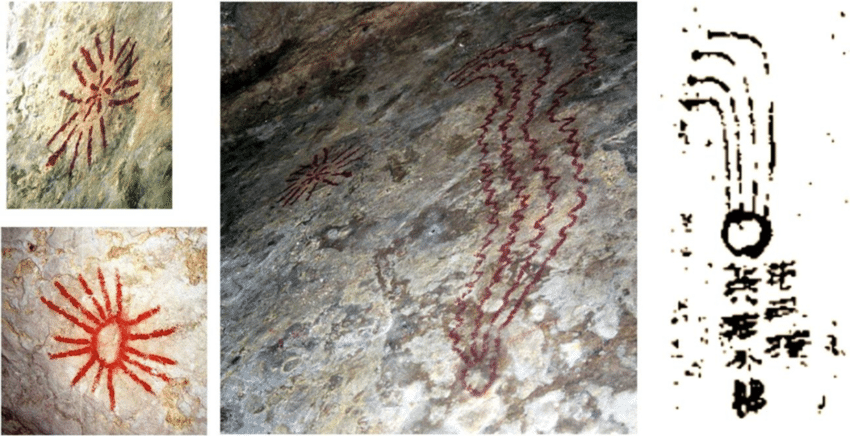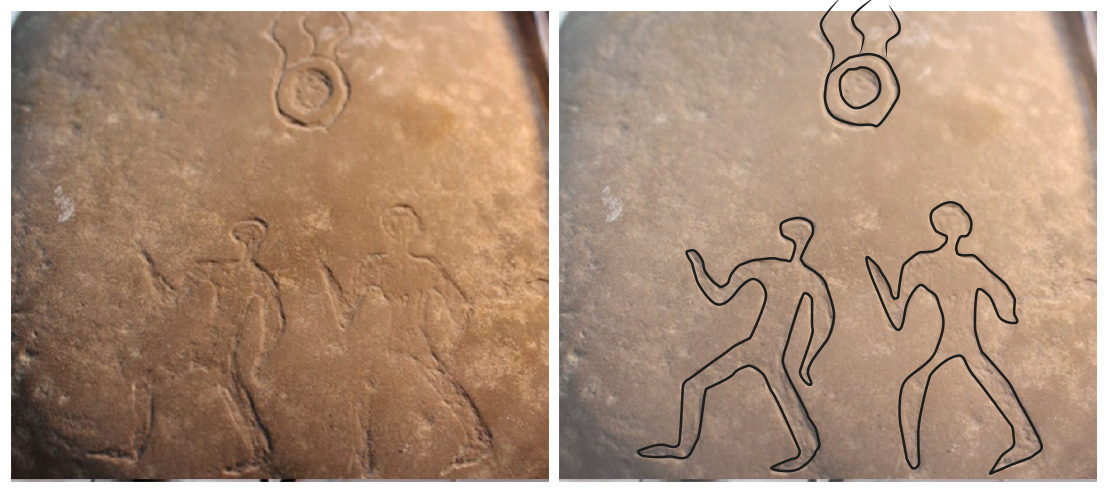The new discovery was conducted by Moroccan researcher and IMO member Abderrahmane Ibhi and by Fouad Khiri, Lahcen Ouknine, Abdelkhalek Lemjidi, and El Mahfoud Asmahri. Moroccan researchers compared the engravings to other petroglyphs discovered previously in the region and also gathered testimonies from eyewitnesses of the fall of the Tissint meteorite in 2011, to reach the conclusion that the petroglyphs date back to ancient time, albeit not providing an idea on how old the engravings are.
The first petroglyphs (called Ida1 by the Moroccan research team) offers a scene of two people seemingly distraught by the fall of a meteor. Identically on the 2nd one (Ida2), Ibhi and his team identified a scene that includes a fleeing anthropomorphic and what it looks like a huge fireball.
On the third petroglyph (Ida3), the engraved scene includes an anthropomorphic, two cattle of different sizes, what it looks like a meteor and a figurative representation of the Sun with concentric circles in the center.
Ibhi and his team noted that the typology of these objects is very similar to the meteor engraving of Toca do Cosmos (Bahia, Brazil) and that of the rock painting in the Fouriesburg district (South Africa). Both artifacts are suspected to depict meteorite falls.

Note that as suggest by J.F. Thackeray (Transvaal Museum, Pretoria) in 1988, comets and meteors have been conceptually associated with trance among at least some population groups in Southern Africa. The depiction of a stripe-like object (comet or meteor) in some prehistoric paintings and engravings, juxtaposed with human figures could reflect conceptual associations with trance experience rather than a specific astronomical event.
Too bad prehistoric people didn't have access to your online fireball report!





Reader Comments
So that would be my first thought.
The names and symbols for Venus across global antiquity might wake more than a moment of considering 'primitives depict a meteor'.
While difficult to untangle the order of events, and the cultural motifs that are then developed culturally from core mythic archetypes the basic ideas of Plasma Mythology make much more sense that mere object impacts and big bangs.
Also the work of plasma physicist Anthony Perratt and his research on ancient petroglyphs is a key to reconsidering that the current state of an electric Universe is different to what it was - but therefore so also is the current expression of consciousness. IE: frightened primitives.
When subjective consciousness began - it was a sense of doer - intending and carrying out an act or making a word (law or spell) from which orders were carried out (order was imposed). Instinctive being has no such sense of separation from the movement of its being.
This 'power' was then seen as the nature of a world of powers, lawmaker, and punisher or healer. Under the Stockholm syndrome, NOT being punished or hurt is seen as love or favour.
There is much more to see than a linear physically framed narrative - but even this account is neutered within the 'religion' of a uniform gradualism - in which millions of years are substituted for catastrophic evolutionary 'phase-shifts' or epochs. And understandably.
However 'apocalyptic fear' is not escaped thereby, and yet the vector of our destruction is our own (human) re-enactment of an archetypal 'Separation' trauma - in which a separative sense of an alien power over life (our thinking) operates the destruction or obstruction to our power to give it.
Of course meteors and comets have been seen. But more to the point - the importance given to the planets and stars and cosmic events is synchronous with the emergence or development of what we call civilisation. the archaeology of which is BENEATH our surface mentality of 'definition and control', that operates as a virtual reality (imaged and sensed model) upon an energetic patterning of which we are largely ignorant.